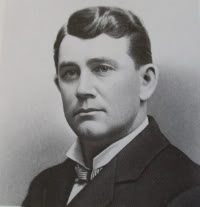But that's in the future. Piecemeal prohibition in Indiana started much earlier, and that, children, is our topic for today.
I've already mentioned the Nicholson remonstrance law, which since 1895 had allowed a township voter to protest the granting of a liquor license to an individual applicant. This was the law that Cyrus Smith tried to use in 1905 to keep W.N. Wagoner out of the Ainsworth saloon — unsuccessfully, as we know.
In 1905 Indiana passed what was known as the Moore amendment to the Nicholson law. The Moore amendment allowed for a remonstrance signed by a majority of all voters in any township or ward to block the granting of any liquor license in that township or ward for two years after the filing of the remonstrance.
Within a few years, some counties had become completely dry by means of the Nicholson-Moore remonstrance law. The drys were not satisfied, however; the Nicholson-Moore process required considerable initiative and legwork, and the result was too piecemeal. Lobbying for stronger measures continued, particularly by the Indiana Anti-Saloon League, led by the Rev. Edward S. Shumaker. Fortunately for them, they had an ally in Indiana's governor, the Republican J. Frank Hanly, himself an ardent dry.

Indiana Governor James Franklin Hanly
Image credit: Wikimedia Commons.
Early in September 1908 Governor Hanly called for a special session of the Indiana legislature to consider the county option law. The Indiana Anti-Saloon League and other temperance advocates brought some 10,000 supporters to Indianapolis for mass demonstrations during the session, while intensively lobbying individual legislators. In spite of some bitter opposition, they ultimately prevailed, and the bill passed. Governor Hanly signed it in the presence of the Rev. Shumaker. (According to Shumaker's biographer, the Governor then handed the Reverend one of the pens he had used to sign the bill; Shumaker kissed it and placed in his pocket.)
By May of 1909, of Indiana's 92 counties, 54 had voted themselves dry by county option. An additional 13 had achieved the same effect through the Nicholson-Moore remonstrance law. The Hobart Gazette printed this map summarizing Indiana's temperance status:

(Click on image to enlarge)
Among all states that allowed for county-option prohibition, Indiana had the largest number of dry counties.
"But what," I hear you asking, "does this have to do with Ainsworth history?" The answer is: nothing. As you can see from the map, Lake County remained wet. Either the citizens of Lake County liked their liquor, or the tourists on whose trade many citizens depended liked it. The latter explanation, according to the Gazette, was put forth by anti-liquor crusaders, who lamented the difficulty of drying out "districts which get any portion of their revenue from resorters, thousands of whom visit Lake, Porter, Laporte and St. Joseph counties during the balmy months. Residents of those sections believe in Chicago things."
Whatever the cause, in Ainsworth, William F. Wollenberg's livelihood was not yet threatened, and he continued serenely to dispense liquor to farmers, railroad men, tourists and drunken whelps.
Sources:
♦ Canup, Charles E. "The Temperance Movement in Indiana." Indiana Magazine of History March and June 1920. Web. 24 July 2010.
♦ "Indiana 'Dryest' State in Country." Hobart Gazette 14 May 1909.
♦ "Indiana's Temperance Status at a Glance." Hobart Gazette 14 May 1909.
♦ Lantzer, Jason S. "Prohibition Is Here to Stay": The Reverend Edward S. Shumaker and the Dry Crusade in America. Notre Dame: University of Notre Dame Press, 2009.


No comments:
Post a Comment